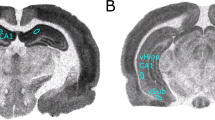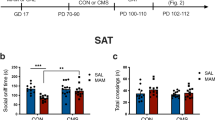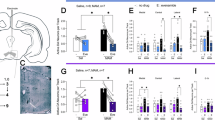Abstract
In addition to prefrontal cortex (PFC) and hippocampus, amygdala may have a role in the pathophysiology of schizophrenia, given its pivotal role in emotion and extensive connectivity with the PFC and hippocampus. Moreover, abnormal activities of amygdala may be related to the anxiety observed in schizophrenia patients and at-risk adolescents. These at-risk subjects demonstrated heightened levels of anxiety, which are correlated with the onset of psychosis later in life. Similarly, rats that received methyl azoxymethanol acetate (MAM) gestationally exhibited higher levels of anxiety peripubertally. In the current study, the heightened anxiety was also observed in adult MAM animals, as well as higher firing rates of BLA neurons in both peripubertal and adult MAM rats. In addition, the power of BLA theta oscillations of adult MAM rats showed a larger increase in response to conditioned stimuli (CS). We showed previously that administration of the antianxiety drug diazepam during the peripubertal period prevents the hyperdopaminergic state in adult MAM rats. In this study, we found that peripubertal diazepam treatment reduced heightened anxiety, decreased BLA neuron firing rates and attenuated the CS-induced increase in BLA theta power in adult MAM rats, supporting a persistent normalization by this treatment. This study provides a link between BLA hyperactivity and anxiety in schizophrenia model rats and that circumvention of stress may prevent the emergence of pathology in the adult.
Similar content being viewed by others
Log in or create a free account to read this content
Gain free access to this article, as well as selected content from this journal and more on nature.com
or
References
Achim AM, Maziade M, Raymond E, Olivier D, Merette C, Roy MA (2011). How prevalent are anxiety disorders in schizophrenia? A meta-analysis and critical review on a significant association. Schizophr Bull 37: 811–821.
Benes FM (1999). Evidence for altered trisynaptic circuitry in schizophrenic1 hippocampus. Biol Psychiatry 46: 589–599.
Benes FM (2010). Amygdalocortical circuitry in schizophrenia: from circuits to molecules. Neuropsychopharmacology 35: 239–257.
Berretta S, Lange N, Bhattacharyya S, Sebro R, Garces J, Benes FM (2004). Long-term effects of amygdala GABA receptor blockade on specific subpopulations of hippocampal interneurons. Hippocampus 14: 876–894.
Berretta S, Munno DW, Benes FM (2001). Amygdalar activation alters the hippocampal GABA system: ‘partial’ modelling for postmortem changes in schizophrenia. J Comp Neurol 431: 129–138.
Cabungcal JH, Counotte DS, Lewis EM, Tejeda HA, Piantadosi P, Pollock C et al (2014). Juvenile antioxidant treatment prevents adult deficits in a developmental model of schizophrenia. Neuron 83: 1073–1084.
Chen L, Perez SM, Lodge DJ (2014). An augmented dopamine system function is present prior to puberty in the methylazoxymethanol acetate rodent model of schizophrenia. Dev Neurobiol 74: 907–917.
Corcoran CM, Smith C, McLaughlin D, Auther A, Malaspina D, Cornblatt B (2012). HPA axis function and symptoms in adolescents at clinical high risk for schizophrenia. Schizophr Res 135: 170–174.
Czeh B, Simon M, van der Hart MGC, Schmelting B, Hesselink MB, Fuchs E (2005). Chronic stress decreases the number of parvalbumin-immunoreactive interneurons in the hippocampus: prevention by treatment with a substance P receptor (NK1) antagonist. Neuropsychopharmacology 30: 67–79.
Devylder JE, Ben-David S, Schobel SA, Kimhy D, Malaspina D, Corcoran CM (2013). Temporal association of stress sensitivity and symptoms in individuals at clinical high risk for psychosis. Psychol Med 43: 259–268.
Du Y, Grace AA (2013). Peripubertal diazepam administration prevents the emergence of dopamine system hyperresponsivity in the MAM developmental disruption model of schizophrenia. Neuropsychopharmacology 38: 1881–1888.
Ferguson SA, Boctor SY (2009). Use of food wafers for multiple daily oral treatments in young rats. J Am Assoc Lab Anim Sci 96: 292–296.
Gill KM, Grace AA (2014). Corresponding decrease in neuronal markers signals progressive parvalbumin neuron loss in MAM schizophrenia model. Int J Neuropsychopharmacol 17: 1609–1619.
Goto Y, Grace AA (2006). Alterations in medial prefrontal cortical activity and plasticity in rats with disruption of cortical development. Biol Psychiatry 60: 1259–1267.
Grace AA, Moore H (1998) Regulation of information flow in the nucleus accumbens: a model for the pathophysiology of schizophrenia. In: Lenzenweger MF, Dworkin RH (eds). Origins and Development of Schizophrenia: Advances in Experimental Psychopathology. American Psychological Association Press: Washington, DC, USA, pp 123–157.
Hall J, Whalley HC, McKirdy JW, Romaniuk L, McGonigle D, McIntosh AM et al (2008). Overactivation of fear systems to neutral faces in schizophrenia. Biol Psychiatry 64: 70–73.
Harris AZ, Gordon JA (2015). Long-range neural synchrony in behavior. Annu Rev Neurosci 38: 171–194.
Hu W, Zhang M, Czeh B, Flugge G, Zhang W (2010). Stress impairs GABAergic network function in the hippocampus by activating nongenomic glucocorticoid receptors and affecting the integrity of the parvalbumin-expressing neuronal network. Neuropsychopharmacology 35: 1693–1707.
Johnstone EC, Ebmeier KP, Miller P, Owens DGC, Lawrie SM (2005). Predicting schizophrenia: findings from the Edinburgh High-Risk Study. Br J Psychiatry 186: 18–25.
Kim JJ, Diamond DM (2002). The stressed hippocampus, synaptic plasticity and lost memories. Nat Rev Neurosci 3: 453–462.
LeDoux J (2000). Emotion circuits in the brain. Annu Rev Neurosci 23: 155–184.
Likhtik E, Pelletier JG, Popescu AT, Pare D (2006). Identification of basolateral amygdala projection cells and interneurons using extracellular recordings. J Neurophysiol 96: 3257–3265.
Likhtik E, Stujenske JM, Topiwala MA, Harris AZ, Gordon JA (2014). Prefrontal entrainment of amygdala activity signals safety in learned fear and innate anxiety. Nat Neurosci 17: 106–113.
Lodge DJ, Behrens MM, Grace AA (2009). A loss of parvalbumin-containing interneurons is associated with diminished oscillatory activity in an animal model of schizophrenia. J Neurosci 29: 2344–2354.
Lodge DJ, Grace AA (2007). Aberrant hippocampal activity underlies the dopamine dysregulation in an animal model of schizophrenia. J Neurosci 27: 11424–11430.
Lodge DJ, Grace AA (2009). Gestational methylazoxymethanol acetate administration: a developmental disruption model of schizophrenia. Behav Brain Res 204: 306–312.
Maren S, Quirk GJ (2004). Neuronal signalling of fear memory. Nat Rev Neurosci 5: 844–852.
Moore H, Jentsch JD, Ghajarnia M, Geyer MA, Grace AA (2006). A neurobehavioral systems analysis of adult rats exposed to methylazoxymethanol acetate on E17: implications for the neuropathology of schizophrenia. Biol Psychiatry 60: 253–264.
Nelson MD, Saykin AJ, Flashman LA, Riordan HJ (1998). Hippocampal volume reduction in schizophrenia as assessed by magnetic resonance imaging. Arch Gen Psychiatry 33–40.
Owens DGC, Miller P, Lawrie SM, Johnstone EC (2005). Pathogenesis of schizophrenia: a psychopathological perspective. Br J Psychiatry 186: 386–393.
Paré D, Collins DR (2000). Neuronal correlates of fear in the lateral amygdala: multiple extracellular recordings in conscious cats. J Neurosci 20: 2701–2710.
Paxinos G, Watson C (2005) The Rat Brain in Stereotaxic Coordinates, 5th edn. Elsevier Academic Press: San Diego, CA, USA.
Pelletier JG, Pare D (2004). Role of amygdala oscillations in the consolidation of emotional memories. Biol Psychiatry 55: 559–562.
Piontkewitz Y, Arad M, Weiner I (2010). Risperidone administered during asymptomatic period of adolescence prevents the emergence of brain structural pathology and behavioral abnormalities in an animal model of schizophrenia. Schizophr Bull 37: 1257–1269.
Piontkewitz Y, Assaf Y, Weiner I (2009). Clozapine administration in adolescence prevents postpubertal emergence of brain structural pathology in an animal model of schizophrenia. Biol Psychiatry 66: 1038–1046.
Piontkewitz Y, Bernstein HG, Dobrowolny H, Bogerts B, Weiner I, Keilhoff G (2012). Effects of risperidone treatment in adolescence on hippocampal neurogenesis, parvalbumin expression, and vascularization following prenatal immune activation in rats. Brain Behav Immun 26: 353–363.
Quarta E, Bravi R, Scambi I, Mariotti R, Minciacchi D (2015). Increased anxiety-like behavior and selective learning impairments are concomitant to loss of hippocampal interneurons in the presymptomatic SOD1(G93A) ALS mouse model. J Comp Neurol 523: 1622–1638.
Rainnie DG, Asprodini EK, Shinnick-Gallagher P (1993). Intracellular recordings from morphologically identified neurons of the basolateral amygdala. J Neurophysiol 69: 1350–1362.
Rosenkranz JA, Grace AA (1999). Modulation of basolateral amygdala neuronal firing and afferent drive by dopamine receptor activation in vivo. J Neurosci 19: 11027–11039.
Rosenkranz JA, Grace AA (2002). Cellular mechanisms of infralimbic and prelimbic prefrontal cortical inhibition and dopaminergic modulation of basolateral amygdala neurons in vivo. J Neurosci 22: 324–337.
Sah P, Faber ESL, Lopez De Armentia M, Power J (2003). The amygdaloid complex: anatomy and physiology. Physiol Rev 83: 803–834.
Schobel SA, Chaudhury NH, Khan UA, Paniagua B, Styner MA, Asllani I et al (2013). Imaging patients with psychosis and a mouse model establishes a spreading pattern of hippocampal dysfunction and implicates glutamate as a driver. Neuron 78: 81–93.
Seidenbecher T, Laxmi TR, Stork O, Pape HC (2003). Amygdalar and hippocampal theta ryhthm synchronization during fear memory retrieval. Science 301: 846–850.
Sherwood NM, Timiras PS A Stereotaxic Atlas of the Developing Rat Brain. University of California Press: Berkeley, CA, 1970.
Thompson JL, Pogue-Geile MF, Grace AA (2004). Developmental pathology, dopamine, and stress: a model of the age of onset of schizophrenia symptoms. Schizophr Bull 30: 875–880.
van Winkel R, Stefanis NC, Myin-Germeys I (2008). Psychosocial stress and psychosis. A review of the neurobiological mechanisms and the evidence for gene-stress interaction. Schizophr Bull 34: 1095–1105.
Volk DW, Lewis DA (2002). Impaired prefrontal inhibition in schizophrenia: relevance for cognitive dysfunction. Physiol Behav 77: 501–505.
Walker EF, Brennan PA, Esterberg M, Brasfield J, Pearce B, Compton MT (2010). Longitudinal changes in cortisol secretion and conversion to psychosis in at-risk youth. J Abnorm Psychol 119: 401–408.
Yung AR, Yuen HP, McGorry PD, Phillips LJ, Kelly D, Dell'olio M et al (2005). Mapping the onset of psychosis: the comprehensive assessment of at-risk mental states. Aust N Z J Psychiatry 39: 964–971.
Zimmerman EC, Bellaire M, Ewing SG, Grace AA (2013). Abnormal stress responsivity in a rodent developmental disruption model of schizophrenia. Neuropsychopharmacology 38: 2131–2139.
Acknowledgements
This work was funded by NIH MH57440 (to AAG). We thank Niki MacMurdo for technical support.
Author information
Authors and Affiliations
Corresponding author
Additional information
Supplementary Information accompanies the paper on the Neuropsychopharmacology website
Supplementary information
Rights and permissions
About this article
Cite this article
Du, Y., Grace, A. Amygdala Hyperactivity in MAM Model of Schizophrenia is Normalized by Peripubertal Diazepam Administration. Neuropsychopharmacol 41, 2455–2462 (2016). https://doi.org/10.1038/npp.2016.42
Received:
Revised:
Accepted:
Published:
Issue date:
DOI: https://doi.org/10.1038/npp.2016.42
This article is cited by
-
GABAA and NMDA receptor density alterations and their behavioral correlates in the gestational methylazoxymethanol acetate model for schizophrenia
Neuropsychopharmacology (2022)
-
Stress impacts corticoamygdalar connectivity in an age-dependent manner
Neuropsychopharmacology (2021)
-
The mGluR2/3 agonist pomaglumetad methionil normalizes aberrant dopamine neuron activity via action in the ventral hippocampus
Neuropsychopharmacology (2020)
-
The impact of D-cycloserine and sarcosine on in vivo frontal neural activity in a schizophrenia-like model
BMC Psychiatry (2019)
-
α7 Nicotinic receptor-modulating agents reverse the hyperdopaminergic tone in the MAM model of schizophrenia
Neuropsychopharmacology (2018)



